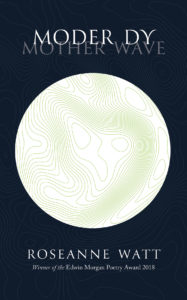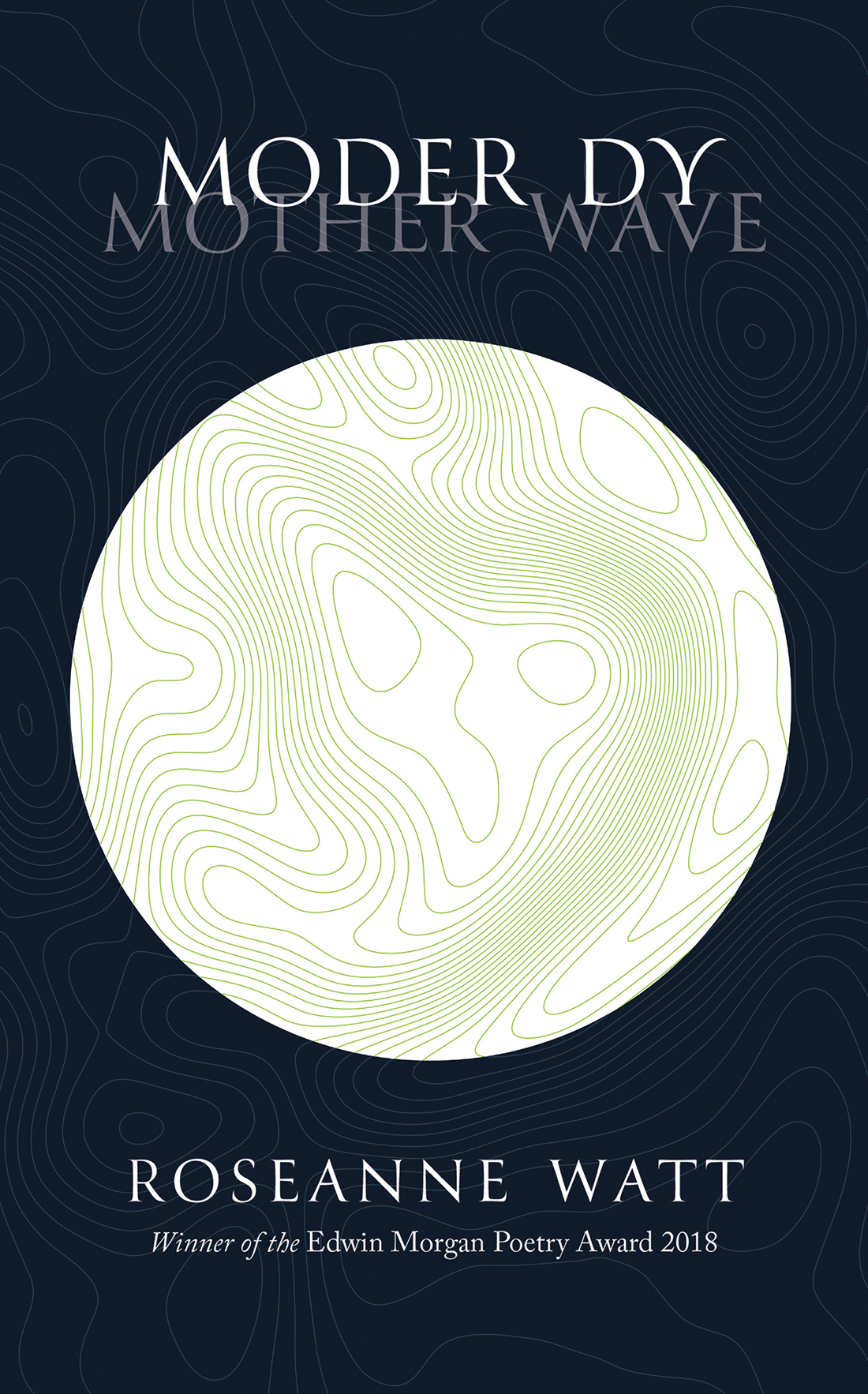Review by Marina Martino
Moder dy is a wave or a current, known for leading back to the safety of shore those who navigate it. It’s an underswell: it flows under the surface of the water, off the southern coast of the Shetlands, untouched by the wind and always in the direction of land. The haafmen, Shetland’s fishermen of the high sea, called it moder, which means mother. To find and navigate moder dy is not easy, and the last haafman known to be able to do it died in 1965. There are signs to be read on the surface of the sea, and only an instinctive knowledge of the currents could aid you on the foggiest days. Many consider it an ‘art’ – forgotten, belonging to a time before the compass and GPS technologies, but if it is still alive in the language of the island, it is still alive in its imagination.
ir mibbe du joost kent dis island
haads its wilt tings closs.
/
or maybe you just knew this island holds
its lost things close.
The gradual disappearing of moder dy from the practice of everyday life has transformed it into a legendary shadow. In her debut collection, Moder Dy (Polygon, 2019), Roseanne Watt captures the sense of something half-forgotten, but that lingers on; something that memory makes vaguer as time passes, but somehow more precise in feeling. Days, places, actions and the details that had defined them cease to be practical and start to be aesthetic or spiritual, locking inside themselves the secret of their functions. How to map moder dy? People are forgetting how to see it in the water. How to map an island out in the North Sea?
The day you mapped your bonhogas
out for me, we saw it
curled like a question mark
at the lip of the hills –
Looking at radar photographs from the 70s, one can catch a glimpse of moder dy, but Watt offers us a different kind of mapping – in this kind, the true transcription of elevations and depressions is substituted by a careful charting of something more mobile and ever-changing, which Shetlandic calls bonhogas. A bonhoga is a “spiritual or childhood place;” in other words, a place reshaped by memory, individual or collective, and a realm of fleeting shades. “The beach is filled with dead things –” a seal, a jellyfish, the debris brought by storms. On the beach jellyfish are left by the tides like “dropped// scoops of translucent ice-cream,” but “we know they are immortal;” next to them, in the churchyard where the dead remain still in the changing of the seasons, others join them brought by parades “as slow as shadows.” The salty steps lock the dead seal in an embrace, a “washed-up old moon;” while the salty marshes that couldn’t lock the birds are left bare by their leaving. Everything is eternally present, but eternally in passing.
… Haegri,
hillside-sentinel, what took you
from those blackened pools
you’ve spent lifespans watching over,
as though you were looking
for the image of some other
world within your own.
Even the haegri, the heron, manifests itself in the sky as an unanswered question, then as “a trick /of slud-light and lisks.” Through the dream-like appearing and disappearing of living and dead things, and places that clearly were, once, organically part of a life, Watt draws for us a map of the island, or of an island, built by memory.
du seems tae fin dysel maist whaar de licht
is slockit: helliers, vodd hooses –
/
you seem to find yourself most where the light
wrecks: sea caves, ruined houses –
 What, exactly, classifies as a bonhoga? Does it have to be a beach, a graveyard, a hill-chain? Does it have to be a place where you can walk on, sit in, look out from? Watt challenges the physical presence of herself and the places of her dwelling – it could be a wind, really, a light, a certain shade of sand, or it could be the mareel, the phosphorence hanging over the surface of the sea, especially in autumn nights. Memory makes things thin, ethereal enough to blur into one another. Watt’s poetry works incessantly to make a present sensation into a knot of impressions from the past – a big sky that confuses itself with the sea becomes “a sky of light, a sea of sky,” one merged into the other. Watt creates a blending space, where the thin contours of what was made contourless are retrieved, and sometimes redrawn altogether to make new forms emerge – ‘an upturned city’, ‘a house of sky’ – spaces as internal as thought and overarching as the atmosphere above the head.
What, exactly, classifies as a bonhoga? Does it have to be a beach, a graveyard, a hill-chain? Does it have to be a place where you can walk on, sit in, look out from? Watt challenges the physical presence of herself and the places of her dwelling – it could be a wind, really, a light, a certain shade of sand, or it could be the mareel, the phosphorence hanging over the surface of the sea, especially in autumn nights. Memory makes things thin, ethereal enough to blur into one another. Watt’s poetry works incessantly to make a present sensation into a knot of impressions from the past – a big sky that confuses itself with the sea becomes “a sky of light, a sea of sky,” one merged into the other. Watt creates a blending space, where the thin contours of what was made contourless are retrieved, and sometimes redrawn altogether to make new forms emerge – ‘an upturned city’, ‘a house of sky’ – spaces as internal as thought and overarching as the atmosphere above the head.
an its lik we’re staagin
abön some sukken,
sindered warld;
a cummelled city,
nönin de hushiebaa
o de raag,
whaar wir shadoos
best faa wis.
/
and it’s like we’re stalking above
some sunken, sundered world;
an upturned city, humming the lullaby of the rain,
where our shadows best become us.
To best become oneself on this island, one has to look for a place where the light is dim, or it wrecks – a blending space. In this light, external clarity is replaced by an internal one, and the reader’s point of view delicately shifts to a privileged position from which to look at memories – slightly askew, slanted. In this rarefied atmosphere everything is close to combustion.
in those smallest devastations
of the light, I fear the silence
which the hills give me back.
The light doesn’t only variate, it creates ‘devastations’ and the silence, so craved, is also the most feared. The sea opens up to sight only to offer far, unreachable distances, where the silence can travel and get lost; while the hills, imposing physically against the horizon, are the ones against which the silence bounces and travels back. The bareness of the landscape and the absence of obstacles to the sight, reflects in the inner rather than outer precision of Watt’s geography, in its weightlessness. “The only tree/ is my own cross –” the only outer space left is the one inside.
This aert has no roots,
no seeds, despite the stones’
mimicry. The only tree
is my own cross;
even the crows know this.
Take vaar if they come.
Memory has the ability to make private the public and to make into the night a “private zone of night.” The lands above which the haegri flies are elastic in their boundaries and in their meanings. They can be surveyed by flight that is not always bird-flight, and they can take seeds that will not flower. To map them, requires a different kind of mapping, and to know them a different kind of knowing.
all hollows meant for holding
something small, still desperately
alive. I’m sorry – I’m afraid
I know only my own dark canopy,
its filtering bones of light.
This kind of knowledge is a difficult one to obtain. It’s a “knowing without knowing”, completely idiosyncratic but necessarily shared, private but symptomatic of a larger atmosphere; small, but part of vaster cycles, currents and winds.
No; we know only the morning
deepening in the spaces
between pebbles, and the jellyfish
returning, dream-like, to the shore.
To obtain it, Watt uses quiet words, scales of precision. Skröf and djoob and shoormall – the sea from only slightly different perspectives. Words like sjusamillabakka, the space between the water and the bank, gludderi, watery and sunny at the same time, or swaar, the darkest point of the night, carry with their exactness a sense of inner and outer clarity. These nuances are perhaps what ultimately make a bonhoga – a question of perspectives. Are you looking at the surface of the sea from the shore, from a boat, or from under water? Are you looking at a memory straight in the eye, or from a slanted point of view?
lost on the boundary of tidemark and stair,
halfway between one dark and another.
In the same way as Watt spells and respells the places of her memory, the language she uses is extremely private and yet communal. The identity of Shetlandic, “a form of scot shaped by sea roads,”, assumes the hues of an intimate history. This is the core of the knowledge in Moder Dy – the awareness of the distance between the private and the public, as well as of the points in which they overlap; the inner knowledge of the spaces in between.
Marina Martino is a poet and translator based in Edinburgh. Born and raised in the north of Italy, she is currently engaged in postgraduate study and research at St Andrews University.
Continue to Giorgio Papitto’s ‘An exemplary shipwreck’ >>

